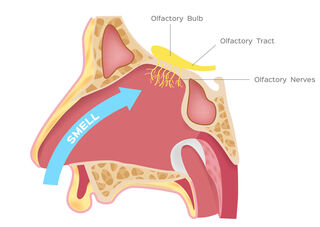Attraction and avoidance are influenced by positive or negative odor valence.
KEY POINTS
- Humans assign “odor valence” to pleasant scents (sizzling bacon) and unpleasant smells (rotten fish).
- New research identifies how the brain encodes positive and negative stimuli and why olfaction is a lightning-fast warning system.
- Smells with negative odor valence are processed faster than pleasant scents. Icky smells trigger instantaneous avoidance behaviors.

Humans and other animals rely on olfaction for survival. Positive smells compel mammals to seek pleasurable rewards (e.g., yummy food, sex). On the flip side, unfavorable odors warn of danger (e.g., toxic fumes, rotten food) and repel us away from things that can cause physical harm or death.
About 5 percent of the typical human brain is dedicated to our olfactory organ, which enables us to distinguish millions of different smells within milliseconds of catching a whiff of any odor inhaled through the nasal passages. Some smells are neutral, but most odors are assigned a positive or negative valence and encoded as good/safe or bad/dangerous by unconscious brain regions.
Odor Valence Compels Us Closer or Repels Us Away
New research (Iravani et al., 2021) from Sweden’s Karolinska Institutet into how the olfactory bulb processes positive and negative “odor valence” sheds light on how an unpleasant smell instantaneously prepares the central nervous system and motor cortex to avoid danger. These findings were published on October 19 in the peer-reviewed journal Proceedings of the National Academy of Sciences.

Behzad Iravani and colleagues found that odors associated with unpleasantness are processed earlier and faster than those with positive valence. Additionally, odors with negative valence trigger an immediate avoidance response via the motor cortex.
“The human avoidance response to unpleasant smells associated with danger has long been seen as a conscious cognitive process, but our study shows for the first time that it’s unconscious and extremely rapid,” Iravani, a researcher at Karolinska’s Department of Clinical Neuroscience, said in a news release. “The results suggest that our sense of smell is important to our ability to detect dangers in our vicinity, and much of this ability is more unconscious than our response to danger mediated by our senses of vision and hearing.”
For this human study, the Swedish researchers used electrophysiological measures from the olfactory bulb (OB) in response to odors with positive and negative valence. Notably, they found that the OB reacts much faster to negative smells than pleasant ones.
Within about 300 milliseconds of whiffing something that smells rotten, the olfactory organ can transmit a signal to the motor cortex that immediately causes people’s bodies to move away from a potentially dangerous odor. This lightning-fast, full-body avoidance behavior triggered by smells with a negative odor valence happens almost instantaneously.
However, smells with a positive valence that might compel people to move closer and take a second whiff are processed via a much slower channel that doesn’t appear to trigger an automatic fight-or-flight preparatory response in the motor cortex.
Amygdala-Striatal Circuits Drive Valence-Specific Behaviors
Another recent study (Zhang et al., 2021) into how positive and negative stimuli compel and repel the mammalian brain found that the basolateral amygdala (BLA) has two distinct classes of neurons that drive valence-specific behavior in mice. These Cold Spring Harbor Laboratory findings were published on October 18 in the peer-reviewed journal Nature Neuroscience.
Negative-valence neurons are activated by aversive or harmful stimuli, whereas positive-valence neurons respond to pleasurable or rewarding stimuli.
In mice, each class of BLA neurons conveys information about positive or negative valence via distinct amygdala-striatal circuits that project from the olfactory tubercle and nucleus accumbens. Hence, the valence-specific motivation to avoid something dangerous or seek something rewarding is linked to valence-specific BLA neurons with distinctive input-output structures.
Notably, both types of valence-specific neurons are scattered throughout the basolateral amygdala and coexist side by side. “They’re spatially intermingled. When you start to image them, you know that some of the neurons respond only to good things, some of the neurons respond only to bad things, just like the pepper and the salt mixed together, and they do different jobs,” senior author Bo Li explained in a news release.
More research into our olfactory-driven motivation circuits is needed to better understand how an odor’s negative or positive valence cues avoidance or seeking behavior via valence-specific brain circuits that may drive addiction, cause anxiety, and trigger post-traumatic stress disorders (PTSD).
References
Behzad Iravani, Martin Schaefer, Donald A. Wilson, Artin Arshamian, Johan N. Lundström. “The Human Olfactory Bulb Processes Odor Valence Representation and Cues Motor Avoidance Behavior.” PNAS (First published: October 19, 2021) DOI: 10.1073/pnas.2101209118
Xian Zhang, Wuqiang Guan, Tao Yang, Alessandro Furlan, Xiong Xiao, Kai Yu, Xu An, William Galbavy, Charu Ramakrishnan, Karl Deisseroth, Kimberly Ritola, Adam Hantman, Miao He, Z. Josh Huang & Bo Li. “Genetically Identified Amygdala–Striatal Circuits for Valence-Specific Behaviors.” Nature Neuroscience (First published: October 18, 2021) DOI: 10.1038/s41593-021-00927-0
Source: How Smells Quickly Repel or Compel Us | Psychology Today Canada













